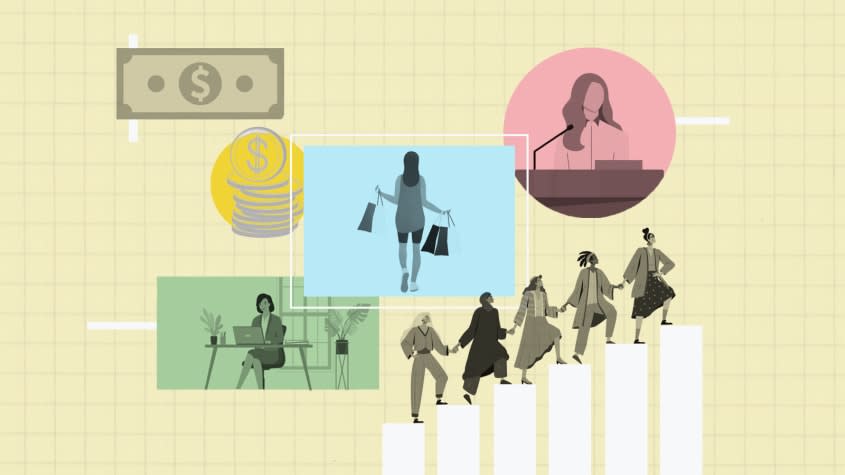How 2023 solidified the market power of women

Certainly, women have long been the ones to make purchasing decisions in the household and hold substantial economic power. According to a new consumer study, 78% of women identify as the primary shopper of their household. And despite seemingly constant barriers to entry that include a stagnant wage gap, limited family-friendly governmental policies, and the enduring "pink tax," women hold increasingly substantial economic power.
A constrained workforce
Women, especially women of color, have been active members of the workforce, even when "middle- and upper-class social norms of the 18th and 19th centuries reinforced the idea that white women should not work outside the home," per the National Park Service. Beginning in the 20th century, more women began to become more active in the workforce, especially with the passing of the 19th Amendment giving women the right to vote. Many women also had the opportunity to further their education, allowing for more opportunities.
Today, women comprise approximately half of the U.S. workforce and still take on the majority of household responsibilities, according to the U.S. Government Accountability Office. And to boot, the wage gap has remained steady, with women making on average 82% of what men earn, per the Pew Research Center. The discrepancy in pay is even more severe for Black, Latino and Indigenous women.
Leadership roles remain largely occupied by men, even in companies and brands that are marketed to women, and very rarely does a company have two female CEOs in a row, reported The New York Times. While progress was being made, the pandemic pushed companies to "make sure they've got the right athlete in the job, regardless of any other factors," causing many to revert to placing men back into C-suite positions previously held by women," Catherine Lepard, who leads executive searches for retail firms at Heidrick & Struggles, told the Times.
Taxation and underrepresentation
And women's economic barriers include overt pricing differences. The "pink tax," the name given to the "discriminatory pricing that inflates the cost of goods marketed to women," as well as services, per Bankrate, is the price hike applied to anything from feminine hygiene products, razors and deodorant to dry cleaning and luxury items. "This may not be about the wage gap directly, but it's just as effective in terms of disenfranchising half of the economy from making their own decisions, from realizing economic independence," J.P. Krahel, an associate professor of accounting at Loyola University, told CBS News.
The U.S. also makes it more difficult for women to thrive financially due to the lack of paid maternity leave and child care, especially given that women serve as caregivers in much higher numbers than men, and women of color face more economic hardship than white women. Even so, as the "majority of primary caregivers for both children and the elderly, women are often buying on behalf of everyone in their households and beyond," stated Forbes.
And women remain poorly represented in the creation of media, entertainment, products and services. "Even as representation of all types in Hollywood is improving, the kinds of movies in which women star aren't stereotypically girly — for better or worse," stated Time, adding that "very few movies manage to cater to women without condescending to them." So it's not surprising that "91% of women believe advertisers don't understand them," reported Kiplinger (a sister site of The Week).
A stalled system
Women have largely felt that the current economic system doesn't work for them. "What's happened is that our economy has changed, and women, people of color, and young folks of color are playing a bigger role … and yet we don't acknowledge that, and in fact, I think our political discourse understates the role women are playing," Heather McCulloch, of the Aspen Institute Financial Security Program and the founder of Closing the Women's Wealth Gap, told The 19th News.
"We live in this society where women control the majority of consumer spending. They make the decisions, and yet we still haven't moved forward, and we have to go into this cycle," Kimberly Lee Minor, the chief executive of consulting firm Bumbershoot, told the Times.
A blockbuster summer
The summer of 2023 has shown how much purchasing power women can demonstrate, particularly regarding products and services specifically made for and by them. The movie "Barbie" reached $1 billion at the global box office, with director Greta Gerwig as the first solo female director to achieve this record-breaking success. And both Taylor Swift's Eras Tour and Beyonce's Renaissance Tour sold out in every city and grossed millions of dollars.
"Instead of women making decisions about purchasing traditional goods that are in some sense a public good for the family, they're actually using their resources to purchase goods and experiences that bring them joy," Misty Heggeness, an economist and professor at the University of Kansas, told The Wall Street Journal. Women's spending of disposable income and the resulting financial success of women-centered entertainment may finally get people listening. "Women may be better positioned than ever to flex their financial strength," per MarketWatch. "There are a record number of women in the U.S. labor force, surpassing prepandemic levels." And "by the year 2028, women will own 75% of the discretionary spending," per Bankrate.
Katherine Wintsch, the CEO of The Mom Complex and author of "Slay Like a Mother," told the Journal, "It's a sense of solidarity that women are willing to pay good money for." Perhaps the market will start listening.

